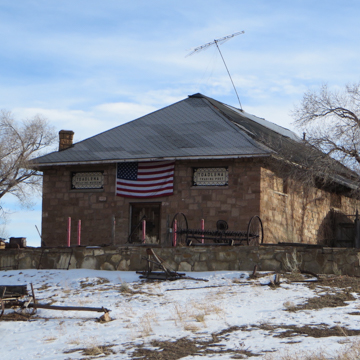You are here
Toadlena Trading Post
Bob and Merritt Smith established the Toadlena Trading Post in 1909, but the Bloomfield family and a crew of Diné stonemasons constructed the current trading post building, one of the most picturesque examples on the Navajo Reservation. George Bloomfield, who purchased the business in 1911, also played an important role in developing the Two Grey Hills weaving style. Between 1915 and 1925, Bloomfield collaborated with Ed Davies, the trader at the nearby Two Grey Hills Trading Post to promote textiles woven from natural, undyed wool. Two Grey Hills-style rugs, with their distinctive brown, tan, grey, black, and white designs include some of the most exceptional works of Diné art ever created.
George and Lucy Bloomfield were Mormons, a group who developed trade relations with the Diné even before the tribe was removed to Bosque Redondo in southeastern New Mexico in 1864. In fact, as the historian Frank McNitt has observed, “the Mormons were the first American traders to the Navajos of any consequence.” As the trading post system evolved after the creation of the Navajo Reservation in 1868, several trading dynasties were founded by Mormon families including the Lees, the Tanners, the Foutzes, and the Burnhams. The Bloomfields acted as traders and missionaries at Toadlena while raising a large family, many of whom eventually managed trading posts across Navajoland.
The beautiful sandstone walls of the Toadlena Trading Post were constructed in 1927 by Julius Bainbridge, John Natani Begay, Enos Natani, Lee Police, Sam Shorty, Slim Jumbo, and Jumbo Bitsilly. The trading post’s interior is remarkable as one of only two on the reservation that retains the historic “bull-pen” arrangement in which merchandise is kept on shelves behind the sales counters (most trading post interiors were converted to accommodate self-service during the mid-twentieth century). The Toadlena Trading Post is also noted for its weaving museum, which displays an outstanding collection of Diné textiles.
References
Berkholz, Richard C. Old Trading Posts of the Four Corners. Lake City, CO: Western Reflections Publishing Company, 2007.
Kelley, Klara B., and Harris Francis. Navajoland Trading Post Encyclopedia. Window Rock, AZ: Navajo Nation Historic Preservation Department, 2018.
Makeda, Lillian, and Klara Kelly, “The Borrego Pass Trading Post Historic District,” McKinley County, New Mexico. National Register of Historic Places Inventory–Nomination Form, 2012. National Park Service, U.S. Department of the Interior, Washington, D.C.
Spears Architects, AIA. Historic Trading Posts of Northwest New Mexico. Santa Fe: New Mexico Historic Preservation Division, 1993.
Winter, Mark. The Master Weavers: Celebrating One Hundred Years of Navajo Textile Artists from the Toadlena/Two Grey Hills Region. Toadlena, NM: Historic Toadlena Trading Post, 2011.
Writing Credits
If SAH Archipedia has been useful to you, please consider supporting it.
SAH Archipedia tells the story of the United States through its buildings, landscapes, and cities. This freely available resource empowers the public with authoritative knowledge that deepens their understanding and appreciation of the built environment. But the Society of Architectural Historians, which created SAH Archipedia with University of Virginia Press, needs your support to maintain the high-caliber research, writing, photography, cartography, editing, design, and programming that make SAH Archipedia a trusted online resource available to all who value the history of place, heritage tourism, and learning.








